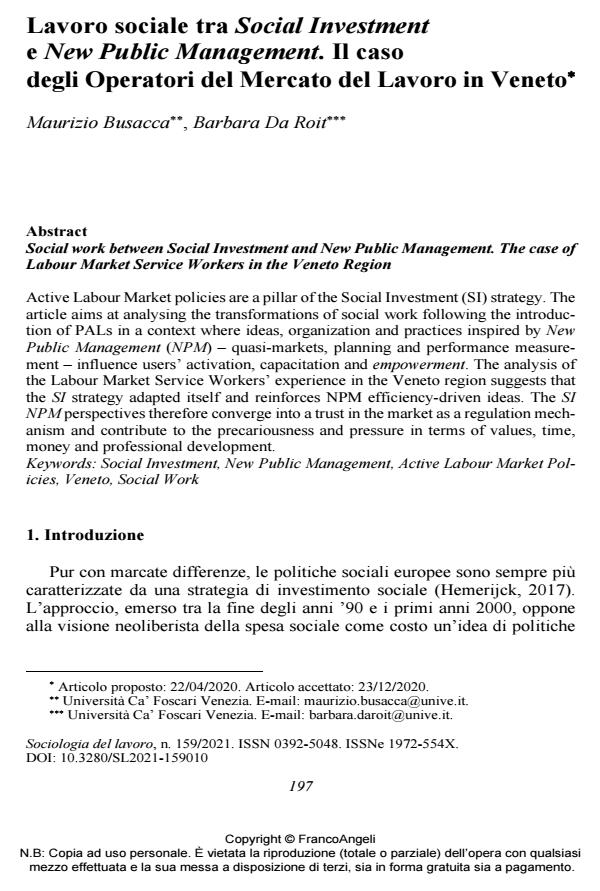Lavoro sociale tra Social Investment e New Public Management. Il caso degli Operatori del Mercato del Lavoro in Veneto
Titolo Rivista SOCIOLOGIA DEL LAVORO
Autori/Curatori Maurizio Busacca, Barbara Da Roit
Anno di pubblicazione 2021 Fascicolo 2021/159
Lingua Italiano Numero pagine 20 P. 197-216 Dimensione file 213 KB
DOI 10.3280/SL2021-159010
Il DOI è il codice a barre della proprietà intellettuale: per saperne di più
clicca qui
Qui sotto puoi vedere in anteprima la prima pagina di questo articolo.
Se questo articolo ti interessa, lo puoi acquistare (e scaricare in formato pdf) seguendo le facili indicazioni per acquistare il download credit. Acquista Download Credits per scaricare questo Articolo in formato PDF

FrancoAngeli è membro della Publishers International Linking Association, Inc (PILA)associazione indipendente e non profit per facilitare (attraverso i servizi tecnologici implementati da CrossRef.org) l’accesso degli studiosi ai contenuti digitali nelle pubblicazioni professionali e scientifiche
Sebbene le politiche attive del lavoro siano uno dei pilastri della strategia di social investment, a cui è affidato il compito di collegare le competenze e il potenziale lavorativo degli individui alla partecipazione al mercato del lavoro, gli studi in questo campo sono ancora limitati e si concentrano soprattutto su questioni di adozione e diffusione dell’approccio di social investment, degli effetti sulle politiche o degli effetti delle politiche sui cittadini. Tuttavia, è stato sostanzialmente trascurato il tentativo di comprendere gli effetti di tali politiche sui lavoratori a cui è affidato il compito di applicarle anche se, come alcuni autori hanno evidenziato, la qualità del lavoro rappresenta un fattore determinante per comprendere gli esiti di tali politiche. Alla luce di ciò, l’obiettivo dell’articolo è quello di analizzare criticamente il rapporto tra i processi di trasformazione del sistema di welfare italiano in un orizzonte di social investment e i modi in cui il lavoro sociale si sta caratterizzando sempre di più come azione di inclusione sociale mediante l’inclusione lavorativa. Per farlo si è scelto di approfondire il caso del sistema Veneto perché in un contesto di forte polarizzazione Nord/Sud del welfare territoriale in Italia, dove nelle regioni del Sud prevale un modello tipico dell’Europa mediterranea e in quelle del Nord emergono sistemi locali più simili a quelli dell’Europa continentale, il Veneto è una regione che si caratterizza per un elevato sviluppo delle politiche e dei servizi al lavoro e con dotazioni (relativamente) elevate di capitale sociale, in altri termini un’area dove i deficit strutturali (in termini di regolazione e risorse) del welfare italiano dovrebbero essere relativamente limitati. I risultati della ricerca evidenziano che gli approcci e i meccanismi promossi dal social investment state rinforzano le idee efficientiste e ossessionate dalla valutazione del new public management.
Parole chiave:Social Investment, Politiche Attive del Lavoro, Professionismo, Veneto, Street Level Bureaucracy
- Linee di cura. La mobilità biografica nello spazio del Terzo Settore Anna D’ascenzio, in WELFARE E ERGONOMIA 2/2023 pp.43
DOI: 10.3280/WE2022-002004 - Social investment e innovazione sociale: il welfare europeo di fronte a una svolta? Maurizio Busacca, in SOCIOLOGIA E RICERCA SOCIALE 129/2023 pp.33
DOI: 10.3280/SR2022-129002
Maurizio Busacca, Barbara Da Roit, Lavoro sociale tra Social Investment e New Public Management. Il caso degli Operatori del Mercato del Lavoro in Veneto in "SOCIOLOGIA DEL LAVORO " 159/2021, pp 197-216, DOI: 10.3280/SL2021-159010